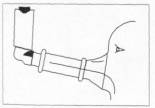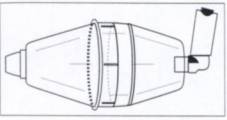|
The
harmonica, a…therapeutic instrument
The origins of the program
Like a lot of people, I have played the harmonica for
many years and have made a lot of friends along the way.
That's the magic of the harmonica; all you need to do
is take one out of your pocket and watch the reactions
around you, all smiles. I expect you too have had similar
experiences
One of the most worthwhile encounters I have had thanks
to the harmonica was with Michel Fedrizzi, a French guitarist
and composer, unfortunately little known to the public.
It was in fact as a result of this meeting that I first
made contact with l’Association
“Planète clé de
Sol” who organise and finance the work of musicians
in the hospitals in and around the Nancy area of France.
At that time, about two years ago, I told Michel that
I had been very interested by the work of Jean-Jacques
Milteau and Greg Szlapczynski in Paris and from there
he suggested quite simply that I spoke to the people in
charge of the association, who were immediately enthusiastic
about the idea.
I didn't know exactly how Jean-Jacques and Greg had worked
in Paris but to me somehow it seemed logical to try to
mix pleasure and practicality by using the harmonica to
help children suffering from respiratory difficulties,
particularly asthma. I therefore contacted the people
from the Association "Planète clé de
Sol", the administrators of the Nancy-Brabois children's
hospital and the professors Monin and Vidailhet, with
a proposition to use the harmonica as a means of therapy.
Having very little knowledge of the illness, I had no
real ideas about what kind of exercises to give to the
children and to what extent the harmonica could prove
to be useful. It was in fact by working with Brigitte
Recroix, a paediatric nurse, that these children's exercises
were developed. Brigitte undertook to teach me a little
about asthma while I helped her with the technical aspects
of the harmonica. With her wide experience of the illness,
Brigitte immediately pinpointed the potential of the harmonica
as an aid to teaching children how to take their medical
treatment correctly.
In Nancy, the harmonica was soon to become one of the
best-adapted tools in helping children suffering from
respiratory difficulties. It is in fact a great teaching
aid as it helps children to understand about breathing
,because the harmonica is the only musical instrument
that is played by both breathing in and out.
What happened next?
Once a week I visited children suffering from asthma
and cystic fibrosis in the Atelier du souffle (the breath
workshop) a building recently completed with the help
of private donations. Supervised by Brigitte Recroix and
myself, the children were to learn how to breathe more
efficiently and how to actually control their breathing
Musically, with the harmonica, I taught them
"Breathe in….and hold the note for a long
time, stop breathing for 5 seconds
Breathe out for a long time through your nose to
empty your lungs"
The intensity of the harmonica's sound enabled the
children to actually HEAR the length of breathing in.
This apprenticeship with the harmonica helped them enormously
with their inhalers, the most important single item that
can help them to Improve their condition.
"Asthma remains today the most frequent of chronic
children's diseases. The last few years have seen an increase
in asthma related disease and mortality throughout the
world. At the same time however, our understanding of
the disease has improved and we know now that asthma in
children is above all an inflammatory illness." (Barnes
1989)
PRINCIPAL TRIGGERS OF ASTHMA ATTACKS
In the home
- Allergies : domestic pets, house-dust mites etc...
- Smoking; active and passive
- Certain types of heating
- Humidity.
Outside the home
- Exposure to allergenic substances (friend's pets pollen
etc.)
- Respiratory infections
- Physical exercise, cold air
.. Passive smoking.
Others
-Low aspirin tolerance
- Food additives (sulphites, monosodium glutamate, etc...)
- Emotional upset and stress
- Gastro-esophageal returns.
Improving the quality of lives
"Asthma can be controlled, providing that the
sufferer has access to appropriate medical treatment and
that he or she can be properly educated both in the administration
of these treatments and in the prevention of asthma
attacks. The main purpose of the education of asthmatics
is to improve their quality of life firstly by teaching
them how relieve the symptoms by correct medication and
secondly by encouraging the adoption of a lifestyle and
environment with a lower risk of provoking asthmatic attacks."
(Boutin and Boulet;1993)
There is no magic potion or foolproof trick that can
work in all situations, but there are certain basic
theoretical principles which can be applied to the creation
of educational programs for asthmatics, which can help
to improve the efficiency of both the medicine and the
preventative measures.
Inhalers
In child asthmatics, the efficiency of the inhaled medicine
is directly related to the amount which reaches the bronchial
tubes, this in turn depends on the number of particles
produced and their characteristics, the type of inhalation
(the rate of intake, length of pause etc.) and the anatomy
of the upper air passages. In order to gain the greatest
benefits from these anti-asthmatic medicines which are
mainly administered by inhalation it is important to understand
the different uses of the inhalers
For this reason, Brigitte Recroix always explains the
exact workings of an inhaler to the children. Generally
speaking children over the age of 11 use a "Ventodisk",
or "Diskus" or perhaps a "TurboHaler",younger
children use inhalation chambers".
Whichever device is chosen, the importance of knowing
how to use it correctly remains the same.
A few different models of inhaler
 An
aérochambreMD for adults and children over five.
It has a one-way valve which blocks off larger particles
and reduces medicine loss. An
aérochambreMD for adults and children over five.
It has a one-way valve which blocks off larger particles
and reduces medicine loss.
 An
aérochambreMD for children from one to five (with
mask). 5 to 10 successive respirations are recommended. An
aérochambreMD for children from one to five (with
mask). 5 to 10 successive respirations are recommended.
 An
aérochambreMD for infants(with mask). An
aérochambreMD for infants(with mask).
 A
VentahalerMD Transparent 750ml conical chamber, with one-way
valve. This valve serves to maintain the medicine in a
spacer within the apparatus until the patient is ready
to inhale. A
VentahalerMD Transparent 750ml conical chamber, with one-way
valve. This valve serves to maintain the medicine in a
spacer within the apparatus until the patient is ready
to inhale.
Taking the medicine
The child must breathe in the medicine, deeply and
for a certain length of time, the inhalation must then
be stopped for 5 seconds to allow the total diffusion
within the bronchial tubes after which the child has to
breathe out long and hard through the nose. For children
under five, several successive inhalations are recommended.
It was for this reason that I introduced the harmonica,
to help the children understand exactly what they must
do when using their inhalers
I ask them to play a long note, drawing on the harmonica,
to then stop breathing for five seconds and lastly to
breathe out through the nose for a long time without letting
out a single note on their harmonica. During the exercise
of course I played them a few catchy melodies
Charline and the giant
When six year old Charline has to take her treatment
she must breathe in deeply to ensure that the medicine
reaches fully into her lungs, but she can only manage
a few short breaths and doesn't believe that she can breathe
either harder or for a longer period. She is sure that
breathing any harder will cause her pain.
I tried straightaway to take her mind off pain by teaching
her how to draw and blow into a harmonica and by playing
a short melody for her. This first contact with the harmonica
went very well but her breathing in and out of the instrument
were so feeble that if she had actually been taking her
medicine at that time she could not possibly have absorbed
it in sufficient quantity
So I told her that only a tiny little mouse would be
able to hear her music if one happened to be passing by,
but if a giant should be anywhere near with his ears so
high in the sky he could not possibly hear and would certainly
be very sad!! I asked her once more to play louder and
longer so that the giant would be able to hear. Suddenly
without a care for the pain which had troubled her so
just a few seconds before, she breathed in much, much
harder so as not to displease any lurking giants.
I could see in her eyes that she had understood just
what she had done, she had realised that she could breathe
in deeply without any sign of pain, and I explained that
all that air she had taken in whilst playing the harmonica
for a giant, could also be found every time she had to
take her medicine. A few days later Charline returned
home, harmonica in her pocket, as happy as could be, to
show her mother the tune that I had taught her
Briefly…
Every week the harmonica goes to visit the children and
little by little, it helps them with their treatment.
Every week these children go home with a harmonica as
a gift, once again thanks to private donations.
If you would like to make a donation, however small please
send it to "L'atelier du souffle", Hôpital
d'enfants de Nancy-Brabois 54000 Nancy-France.
Every year about 600 asthmatic children are admitted
at the Nancy-Brabois hospital. Some stay for just one
day, others may stay a little longer following a more
severe attack. For the time being I only visit the children
once a week, so it is generally this kind of patient that
I see the most frequently. The harmonica classes and the
breathing practice sessions are by no means obligatory
and of course we cannot insist on the participation of
the children brought regularly by their parents for treatment.
If however the word gets round, everyone must surely realise
the real impact of the harmonica in teaching the children
how to correctly take their medicine
.
Medical treatment is efficient provided it is taken
under optimal conditions. The harmonica can genuinely
help children to understand, which enables them to do
for themselves exactly what is necessary to improve their
condition.
If you have ever given a harmonica to a child you will
surely have noticed that spark of wonderment in their
eyes, if you haven't already done so, then it's never
too late!
Paul Lassey, Nancy-France.
http://paul.lassey.free.fr
|